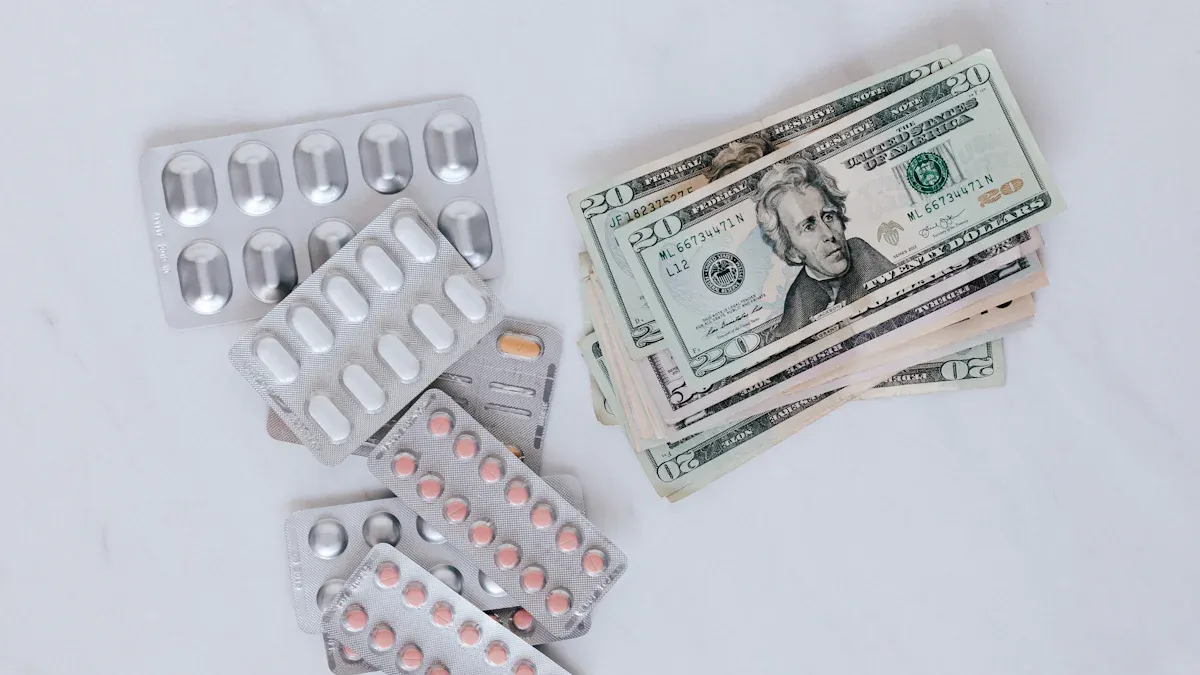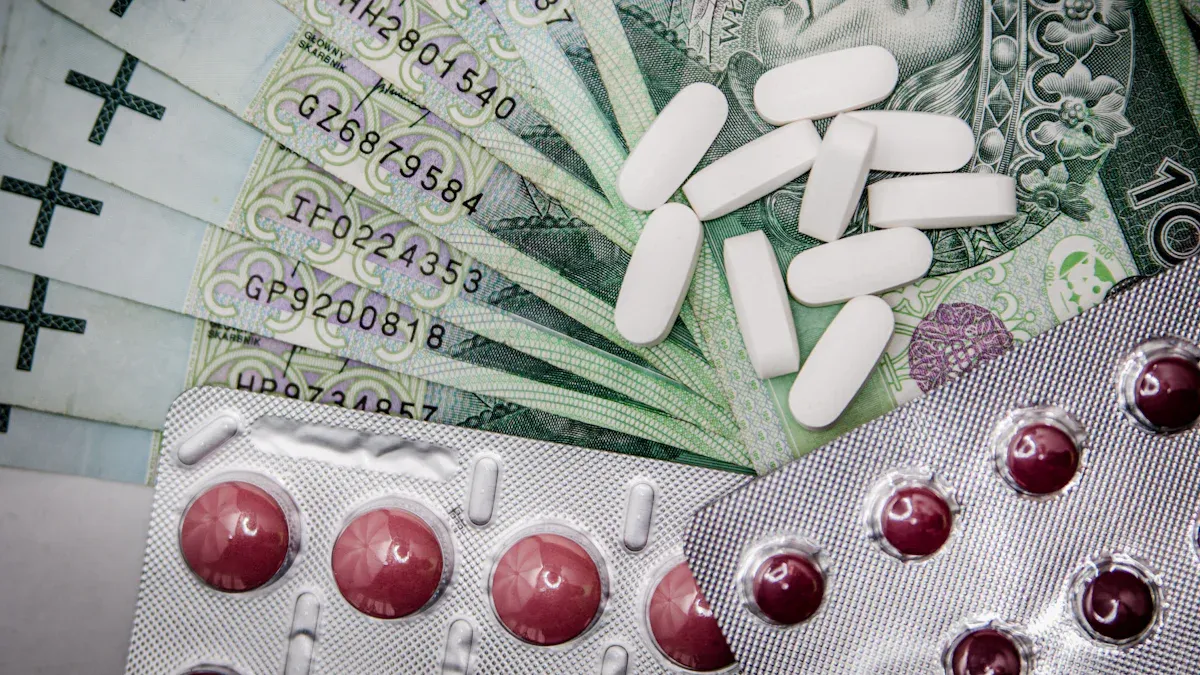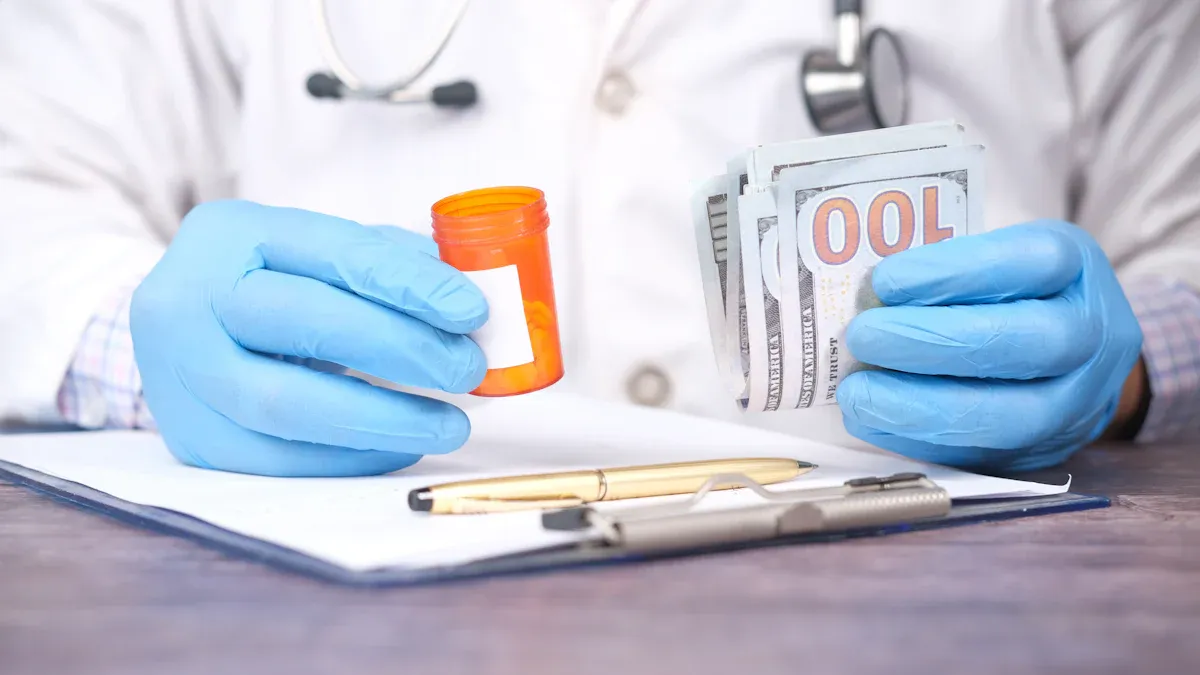Why Are Cancer Drugs So Expensive and How They Affect Patients

Cancer drugs often come with staggering price tags, highlighting the issue of 'Pharmaceutical Pricing: The True Cost of Cancer Drugs,' and leaving many patients struggling to afford life-saving treatments. Developing a single drug can cost up to $2.6 billion, driven by extensive research, clinical trials, and regulatory hurdles. Nearly all cancer drugs approved in 2012 exceeded $100,000 annually, with U.S. prices being 50% to 100% higher than in other countries. These costs directly affect you as a patient. Out-of-pocket expenses for cancer care can reach thousands of dollars monthly, with some patients spending over 20% of their income. Such financial burdens force many to delay or skip treatment, worsening health outcomes.
Key Takeaways
Making cancer drugs can cost as much as $2.6 billion. This is because of lots of research and testing.
Expensive drugs make some patients wait or avoid treatment. This can make their health worse.
Changing insurance rules and price talks can help patients pay less.
Advocacy groups help by asking for clear and fair drug prices.
Faster approval of generic drugs can bring more choices and lower costs.
Pharmaceutical Pricing: The True Cost of Cancer Drugs

The Role of Research and Development
Expensive clinical trials and regulatory studies
Developing cancer drugs involves extensive research and clinical trials, which contribute significantly to their high prices. Clinical trials require years of testing to ensure safety and efficacy. These trials often involve thousands of participants and cost billions of dollars. For example, a study by DiMasi et al. estimated the cost of developing a new drug at $2.6 billion, a sharp increase from earlier estimates. Another analysis by Prasad and Mailankody found that the average cost to develop a cancer drug was $648 million, highlighting variability in estimates.
Evidence Type | Description |
|---|---|
R&D Costs | DiMasi et al. estimated new drug development costs at $2.6 billion. |
Clinical Trial Expenditures | Many drugs fail during development, adding to overall costs. |
Pricing Strategies | Foundational research often receives public funding, challenging narratives. |
High failure rates in drug development
Drug development is a high-risk process. Most drugs fail during clinical trials, meaning companies must recover these losses through the pricing of successful drugs. On average, only 1 in 10 drugs that enter clinical trials receives FDA approval. This low success rate drives up costs, as companies spread the expenses of failed drugs across the prices of approved ones.
Market Exclusivity and Patents
Monopoly pricing during patent protection
Patents and market exclusivity allow pharmaceutical companies to maintain high prices for extended periods. Patents typically last 20 years, but additional exclusivity periods can extend this by 6 to 12 years. This results in an average of 12 to 16 years of market exclusivity, during which companies face little to no competition. Without competition, manufacturers can set prices as high as the market will bear, significantly impacting affordability.
Delays in generic drug availability
Generic drugs provide a more affordable alternative, but delays in their availability keep prices high. Companies often use legal tactics to extend exclusivity, such as filing additional patents on minor modifications. These strategies prevent generics from entering the market, prolonging the period of high pricing.
Pricing Strategies and Profit Margins
Lack of transparency in pricing
Pharmaceutical companies rarely disclose how they determine drug prices. While they cite high R&D costs, studies suggest these costs may be overstated. For instance, foundational research often receives public funding, yet companies claim sole credit for innovation. This lack of transparency makes it difficult to assess whether prices are justified.
Influence of pharmaceutical companies on pricing
Pharmaceutical companies wield significant influence over pricing. A recent analysis by Prasad and Mailankody revealed that the average cost to develop a cancer drug was $648 million, far lower than the $2.6 billion often cited. Critics argue that companies inflate R&D costs to justify high prices.
"A recent estimate by DiMasi et al. placed the cost of new drug development at $2.6 billion, a three-fold increase from 2003. However, this estimate overlooks subsidies provided through R&D tax credits."
These strategies ensure high profit margins, often at the expense of patients.
Regulatory and Approval Barriers
Stringent FDA approval processes
The FDA plays a critical role in ensuring that cancer drugs are safe and effective. However, its approval process is rigorous and time-consuming. You might not realize that the FDA evaluates drugs for safety and efficacy but does not set a minimum standard for how much benefit a drug must provide. This allows some drugs to receive approval even if they offer only small improvements in outcomes.
The FDA reviews drugs for safety and efficacy, but has no set minimum amount of benefit to define efficacy. At the same time, the FDA is forbidden by law from considering price. This leads to a situation where drugs can be approved without a significant demonstration of benefit, allowing pharmaceutical companies to set high prices for drugs that may only provide small, incremental benefits.
This process often results in high costs for cancer drugs. Pharmaceutical companies justify these prices by pointing to the lengthy and expensive approval process. While the FDA ensures patient safety, the lack of price regulation contributes to the rising costs of treatments.
Costs associated with meeting regulatory standards
Meeting regulatory standards adds another layer of expense to cancer drug development. Companies must conduct extensive testing to comply with FDA requirements. These tests include preclinical studies, clinical trials, and post-market surveillance. Each phase demands significant resources, including specialized staff, advanced technology, and time.
The costs don’t stop there. Companies also face fees for submitting applications to the FDA. For example, the Prescription Drug User Fee Act (PDUFA) requires manufacturers to pay millions of dollars for each new drug application. These expenses increase the overall cost of bringing a drug to market.
When you consider these factors, it becomes clear why cancer drugs are so expensive. The combination of stringent approval processes and high compliance costs significantly impacts pharmaceutical pricing: the true cost of cancer drugs.
The Impact of High Cancer Drug Costs on Patients

Financial Strain on Patients and Families
Out-of-pocket expenses and medical debt
High cancer drug costs place a significant financial burden on you and your family. Out-of-pocket expenses for cancer care can range from $1,730 to $4,727 annually, far exceeding the costs faced by individuals without cancer. For patients aged 18 to 64, 13.4% spend over 20% of their income on treatment. Among Medicare beneficiaries, the average out-of-pocket expense reaches 23.7% of household income, with 10% spending more than 60%. These financial pressures often lead to medical debt or even bankruptcy.
When faced with such costs, you may struggle to adhere to treatment plans. Studies show that up to 70% of Medicare Part D patients discontinue therapy due to high expenses. For oral cancer drugs, out-of-pocket costs exceeding $500 result in a 25% abandonment rate, compared to just 6% for costs under $100. These financial challenges not only affect your ability to access care but also compromise your overall quality of life.
Impact on savings and quality of life
The financial strain of cancer treatment can deplete your savings and force lifestyle changes. Many patients exhaust their savings or incur debt to afford medications. This financial burden often leads to reduced spending on essentials like food and housing, further impacting your well-being. The stress of managing these expenses can overshadow the focus on recovery, making it harder to maintain a good quality of life.
Limited Access to Treatment
Patients forced to delay or forgo treatment
High drug prices often force you to make difficult decisions about your care. Some patients delay or forgo treatment entirely due to financial constraints. For example, 17% of multiple myeloma patients report treatment delays, while 10% discontinue therapy altogether. Out-of-pocket costs exceeding $500 are linked to higher rates of abandonment, highlighting the direct impact of pricing on access to care.
Disparities in access based on income and insurance
Income and insurance status play a critical role in determining your access to cancer treatment. Patients with lower incomes or inadequate insurance face greater challenges in affording medications. Nearly one-third of Medicare beneficiaries fail to initiate prescribed oral anticancer drugs within 90 days, with initiation rates 35% lower among those without subsidies to reduce costs. These disparities create unequal outcomes, leaving vulnerable populations at a disadvantage.
Emotional and Psychological Toll
Stress and anxiety over affordability
The financial burden of cancer drugs can take a toll on your emotional well-being. Nearly 29% of patients report experiencing "high or overwhelming" financial distress, while 65% face clinically significant levels of overall distress. This stress often stems from the fear of not being able to afford life-saving treatments, adding to the challenges of coping with the disease itself.
Impact on mental health and family dynamics
Financial distress doesn’t just affect you—it impacts your family as well. Many patients report altering their lifestyles to manage costs, with 89% adopting strategies like cutting back on non-essential spending. These changes can strain family relationships and create tension. Emotional distress linked to financial struggles often correlates with a lower quality of life, making it harder for you and your loved ones to navigate the challenges of cancer treatment.
Solutions to Make Cancer Drugs More Affordable
Legislative and Policy Changes
Price caps and negotiation for Medicare/Medicaid
Legislative measures like price caps and Medicare negotiations can significantly reduce cancer drug costs. The Inflation Reduction Act allows Medicare to negotiate drug prices, a pivotal step toward affordability. This change could save the federal government nearly $100 billion over ten years while lowering out-of-pocket costs for you and other patients.
Proposal | Description | Potential Savings |
|---|---|---|
Medicare Negotiation | Allowing Medicare to negotiate drug prices | $40 to $80 billion annually |
International Reference Pricing | Benchmarking U.S. drug prices against other countries | Prevents inflated prices |
Value-Based Pricing | Pricing reflects clinical benefit of drugs | Aligns costs with value |
Competition in Generics/Biosimilars | Facilitating faster approvals | Drives down prices |
These policies aim to balance affordability with innovation. For example, faster generic approvals increase competition, driving down prices and improving access to life-saving treatments.
Encouraging competition through faster generic approvals
Delays in generic drug availability keep prices high. By streamlining the approval process, you could benefit from more affordable alternatives sooner. Policies that encourage competition, such as reducing patent extensions, ensure that generics and biosimilars enter the market faster. This approach not only lowers costs but also increases treatment options for patients like you.
Insurance Reforms
Expanding coverage for cancer treatments
Insurance reforms play a critical role in making cancer drugs more affordable. Expanding coverage ensures that you have access to necessary treatments without excessive financial strain. Before the Affordable Care Act (ACA), nearly 45% of households faced healthcare expenses exceeding 10% of their income. By improving coverage, reforms can reduce this burden and help you focus on recovery instead of costs.
Reducing out-of-pocket costs for patients
High out-of-pocket expenses often force you to delay or skip treatment. Insurance reforms that cap these costs can alleviate financial stress. For instance, 30% of cancer patients report concerns about affording treatment, while 19% who discuss costs with their doctors experience reduced financial burdens. Expanding subsidies and reducing copayments can make treatments more accessible, improving outcomes for patients across income levels.

Innovations in Drug Development
Streamlining clinical trials to reduce costs
Innovations in drug development can lower the cost of cancer drugs. Streamlining clinical trials reduces expenses, making treatments more affordable for you. Adaptive trial designs, which adjust based on early results, save time and resources. These methods ensure that effective drugs reach the market faster, benefiting patients without compromising safety.
Public-private partnerships to fund research
Collaborations between public institutions and private companies can also reduce costs. Public funding supports foundational research, while private companies handle development and distribution. This shared responsibility lowers the financial burden on pharmaceutical companies, enabling them to price drugs more reasonably. For example, partnerships like these have successfully funded breakthrough treatments while maintaining affordability.
Advocacy and Patient Support
Role of patient advocacy groups
Patient advocacy groups play a vital role in addressing the high cost of cancer drugs. These organizations work tirelessly to represent your interests and push for changes that make treatments more affordable. They emphasize the need for transparency in drug pricing, which helps you understand how prices are set and why they remain so high. Advocacy groups also highlight the burden of out-of-pocket costs, which often prevent you from accessing necessary care.
Their efforts often involve collaboration with other stakeholders, including policymakers, healthcare providers, and pharmaceutical companies. Together, they aim to create solutions that reduce drug costs and improve access to life-saving treatments.
Some key contributions of patient advocacy groups include:
Promoting transparency in drug pricing to ensure fairer costs.
Advocating for reforms that address high out-of-pocket expenses.
Building partnerships with stakeholders to tackle rising drug prices.
By amplifying your voice, these groups help drive policy changes that prioritize your needs and make cancer treatments more accessible.
Raising awareness about affordability issues
Raising awareness is another critical step in making cancer drugs more affordable. Advocacy groups and individuals like you can educate the public about the financial challenges of cancer treatment. Sharing stories about the impact of high drug costs can inspire action and encourage others to join the fight for change.
Public campaigns often focus on the human side of the issue. They highlight how financial barriers affect your ability to receive timely care. These efforts aim to shift public opinion and pressure policymakers to take action.
You can also contribute by supporting these campaigns or sharing your experiences. Every voice matters in the effort to make cancer treatments more affordable for everyone.
The high cost of cancer drugs stems from multiple factors, including research expenses, market exclusivity, and pricing practices. These rising prices have outpaced household income growth, with the average annual cost of cancer drugs increasing from $54,100 in 1995 to $207,000 in 2013. This financial burden affects you directly, creating challenges like limited access to treatment and emotional distress.
Recommendation | Description |
|---|---|
Minimize financial toxicity | Reduce out-of-pocket costs to protect your well-being and access to care. |
Stimulate competition | Promote generics and biosimilars to lower prices through market competition. |
Ensure FDA resources | Provide adequate resources for efficient drug safety and efficacy reviews. |
Invest in research | Support biomedical research to develop innovative, high-value treatments. |
Addressing these challenges requires a multifaceted approach. Legislative reforms, insurance changes, and innovations in drug development can help reduce costs. Collaboration among policymakers, pharmaceutical companies, and patient advocacy groups is essential to balance affordability with continued innovation. By working together, stakeholders can ensure that life-saving treatments remain accessible to you and others in need.
FAQ
What makes cancer drugs so expensive?
Cancer drugs cost a lot because of high research expenses, lengthy clinical trials, and strict regulatory requirements. Companies also use patents to maintain monopoly pricing, keeping costs high for years. These factors combine to create the steep prices you see.
How do high drug costs affect patients?
Expensive cancer drugs lead to financial strain, forcing you to make tough choices like delaying or skipping treatment. This impacts your health, savings, and emotional well-being. Many patients face medical debt or bankruptcy due to these costs.
Are there affordable alternatives to expensive cancer drugs?
Generic drugs and biosimilars offer cheaper options. However, delays in their availability often limit access. Advocacy for faster approvals and competition can help you access these alternatives sooner.
Can insurance help reduce cancer treatment costs?
Insurance can lower your out-of-pocket expenses, but coverage varies. Expanding insurance reforms, like subsidies and copayment caps, can make treatments more affordable for you and improve access to care.
What can you do to advocate for affordable cancer drugs?
You can support patient advocacy groups, share your story, and raise awareness about affordability issues. These efforts push for policy changes and transparency in pricing, helping make treatments more accessible for everyone.
See Also
Exploring Various Cancers Associated With AIDS
Recognizing Symptoms and Treatment Options for Duodenal Cancer
Understanding Endometrial Cancer: Symptoms and Key Information
